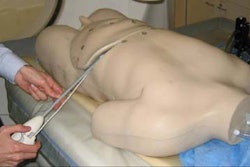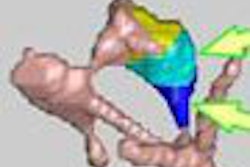The largest population-based study to date -- involving more than 4,000 people -- has found that a calcium score determined by electron beam CT (EBCT) is more accurate than Framingham scores or C-reactive protein tests in gauging coronary disease risk.
The study by Dr. Alan Guerci and colleagues at the St. Francis Hospital in Roslyn, NY, is slated for expedited publication in an upcoming issue of the Journal of the American College of Cardiology (JACC, July 5, 2005, Vol. 46:1).
While five earlier longitudinal studies have shown that coronary calcium scores predict cardiovascular events, the authors note, "these same studies have failed to end the debate over the incremental value of the coronary calcium score relative to standard risk factors."
"Specifically, because of concern about referral bias and/or inaccuracies in self-reported risk factors, the evidence presented in four positive, retrospective analyses of commercial databases has not been considered powerful enough to override the initially negative results from a prospective study of a highly selected population," the author wrote.
In the latest study, researchers analyzed the outcomes from 4,613 asymptomatic volunteers ages 50 to 70 who underwent EBCT scanning of the coronary arteries between 1996 and 1999.
At follow-up a mean of 4.3 years later, 119 of the patients had at least one atherosclerotic cardiovascular disease event, including 40 coronary deaths or nonfatal myocardial infarctions, 59 coronary revascularization procedures, seven nonhemorrhagic strokes, and 13 peripheral vascular surgeries.
The researchers found that those patients who sustained the events had higher baseline calcium scores. Coronary calcium score predicted the events independently of standard risk factors and C-reactive protein results (p = 0.004) and was superior to the Framingham risk index for predicting events (p = 0.0006).
They also found that coronary calcium scores enhanced the stratification of those falling into the Framingham categories of low, intermediate, and high risk (p < 0.0001).
"Our study creates a very strong argument for scanning all patients at intermediate risk according to the Framingham criteria," Guerci said in a statement released by St. Francis Hospital.
"Increasing the accuracy of risk stratification through the use of fast CT scanning provides a very direct benefit to patients," Guerci added. "Many patients classified at intermediate risk with clear signs of underlying disease can get potentially lifesaving treatment, while others with no signs of disease can be spared an unnecessary and expensive regimen of medications."
However, the researchers also found in a companion study that EBCT isn't effective for monitoring response to cholesterol-lowering therapy.
More than 1,000 patients with coronary calcium scores above the 80th percentile for age participated in a double-blind, placebo-controlled substudy of atorvastatin and vitamins E and C (JACC, July 5, 2005, Vol. 46:1).
While treatment had a significant desired effect on total cholesterol, triglycerides, and cardiovascular events, the cholesterol reductions did not retard the rate of progression in patients' coronary calcium scores.
By Tracie L. Thompson
AuntMinnie.com staff writer
June 27, 2005
Related Reading
CT coronary calcium results vary by scanner, body type, May 31, 2005
Coronary calcium predicts brain lesions, cognitive decline in the elderly, April 28, 2005
As cardiac CT interest heats up, so does EBCT, MDCT debate, March 31, 2005
Patients shape up after viewing CT scans of their own blocked arteries, March 24, 2004
Coronary artery calcium detected by tomography may predict heart disease, May 15, 2003
Copyright © 2005 AuntMinnie.com




















